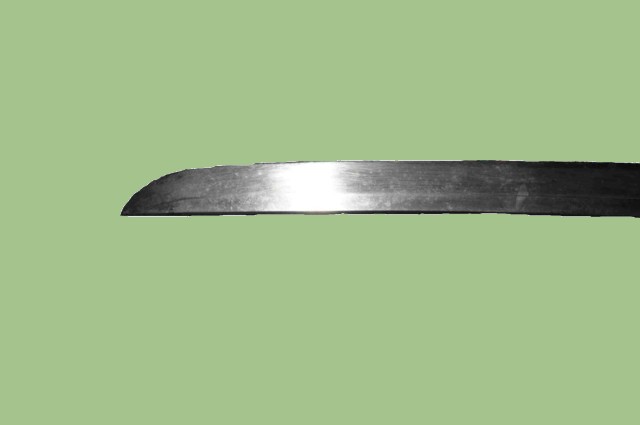SAMURAI SWORD 32 - 1800's TANTO
The Samurai warrior employed the Tanto knife for close combat situations. There were times when
the space available for fighting was limited, as it would be inside a room.
The item featured on this page is a Japanese Tanto knife. Produced in the mid to late 1800's. The knife
is dressed in traditional attire.

The scabbard is beautifully executed. The main body is black lacquered. A suspension ring is built to one
side. It is here that close to half of the length of the scabbard is ribbed, however, the ribbed pattern is only
applied to one side.
The top and bottom sections of the scabbard are decorated with red flowers, more than likely a Chrysanthemum
representation.

The Tsuba is of black color. Not much of a design other than a couple of oval openings to each side.


The following pictures show a closeup view of the Habaki. The upper half is adorned with vertical lines applied
at an angle and bundled close together. This design is known as "Rain pattern". The bottom half is void of any
design. Just plain.

|
This page is a recognition and identification guide for Samurai swords.
Multiple detailed photos of a specific sample are provided. Descriptions point
out clearly defined points that should be noted.
One of the most commonly asked questions is "How much is my Samurai Sword worth?".
A price guide is included here to address this question. The value of the swords is
reviewed over a period of several years. A trend can be observed. The present worth
of the edge weapons in the collector's market is illustrated.
This service is provided free of charge to the visitor/enthusiast courtesy of
MilitaryItems.com,
a company dedicated to the preservation of military history and to providing quality
military antiques and collectibles to museums, institutions and the general public.
|
|

The handle is wrapped with a black cloth. menuki in the shape of a bird adorn both sides of the handle. The
pommel has a metal cap which used to have a guilded design on top, however most of it has been rubbed off. A
metal ring is placed at the base of the handle and has some flowe decorations.



This Samurai Sword may be currently reproduced.
It is becoming more difficult to be able to tell the fake ones from the real ones because
the quality of the reproductions is improving. The collector must become familiarized with
the construction style and materials employed in the manufacturing of this item.
Attention to the details is critical in order to be able to determine the authenticity of
the collectible.
If you have an interest is seeing other Japanese Samurai swords, you can do so by going to our
Japanese Samurai Swords Price Guide
identification guide. Where we cover Samurai swords from all periods.
| 




